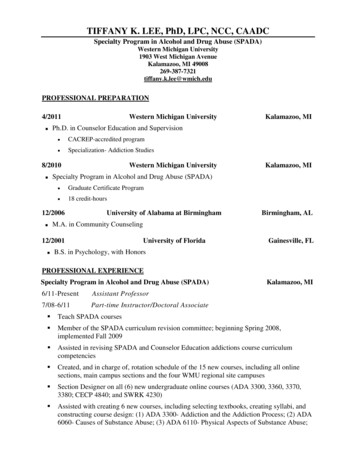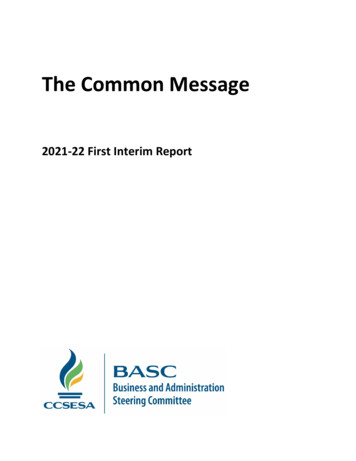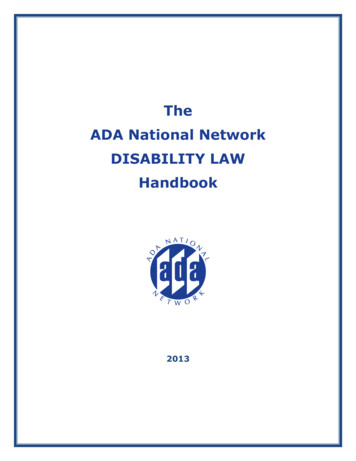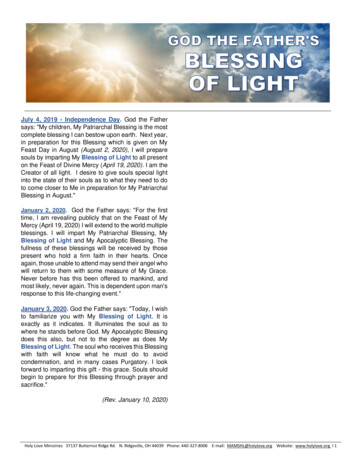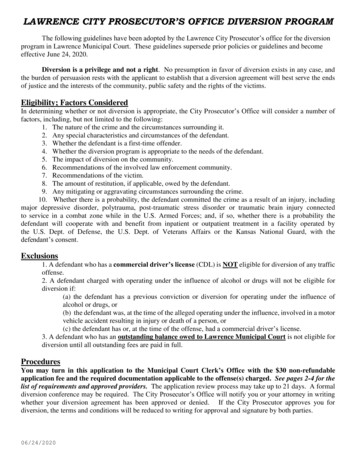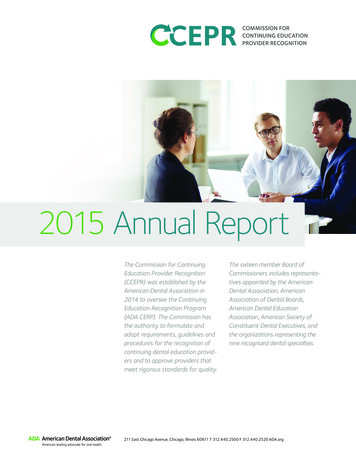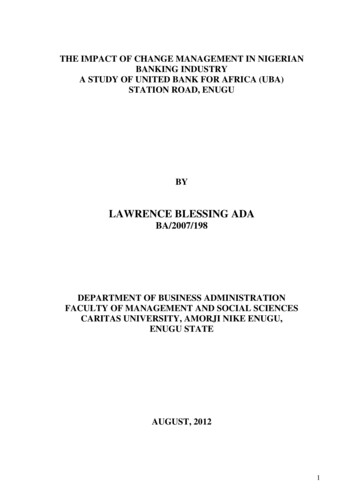
Transcription
THE IMPACT OF CHANGE MANAGEMENT IN NIGERIANBANKING INDUSTRYA STUDY OF UNITED BANK FOR AFRICA (UBA)STATION ROAD, ENUGUBYLAWRENCE BLESSING ADABA/2007/198DEPARTMENT OF BUSINESS ADMINISTRATIONFACULTY OF MANAGEMENT AND SOCIAL SCIENCESCARITAS UNIVERSITY, AMORJI NIKE ENUGU,ENUGU STATEAUGUST, 20121
TITLE PAGETHE IMPACT OF CHANGE MANAGEMENT IN NIGERIANBANKING INDUSTRYA STUDY OF UNITED BANK FOR AFRICA (UBA)STATE ROAD, ENUGUBYLAWRENCE BLESSING ADABA/2007/198A RESEARCH PROJECT SUBMITTED TO THE EPARTMENTOF BUSINESS ADMINISTRATIONFACULTY OF MANAGEMENT AND SOCIAL SCIENCECARITAS UNIVERSITY, AMORJI NIKE ENUGUENUGU STATESUBMITTED IN PARTIAL FULFILLMENT OF THEREQUIREMENTS FOR THE AWARD OF BACHELOR OFSCIENCE (B.SC) DEGREE IN BUSINESS ADMINISTRATIONAUGUST, 20122
CERTIFICATIONThis is to certify that this project by Lawrence Blessing with Reg. NoBA/2007/198 has been read and approved in partial fulfillment of the requirementfor the Award of Bachelor of Science (B.Sc) Degree in Business Administration,Caritas University, Amorji Nike, Enugu, Enugu State.ByMr. Melletus AgboProject Supervisor DateProf G. U. NwangumaHead of Department .Date3
DEDICATIONThis project is dedicated to the Almighty God for his love, care, kindnessand mercy on me and for guiding me through my academic pursuit.4
ACKNOWLEDGMENTMy sincere appreciation goes to my supervisor Mr. Melletus Agbo whosevaluable suggestions and constructive criticisms contributed substantially to thesuccess of this research.My appreciation also goes to my HOD, Prof G.U. Nwanguma and mylecturers, Mr. Walter Ani, Mr. Innocent Ubawuike, Mr. Eziedo Kenneth for theiracademic support and encouragements.My gratitude goes to my beloved mother Mrs Esther Ijiga Lawrence whocontributed immensely to my education and my two siblings Cecilia and Gracemy Aunties and uncles for their supports and my friends Angela Idogo, UcheMaryann Nkechi, step hanie Dike, Aku Abaje Fatima, Ekoli Ukamaka andDominic Emmanuel, Eya Mercy, Iwodi Clemtina who support me in this projectalso my friend Blessing Ogechukwu Okafor.5
ABSTRACTThe research topic of this study is the impact of change management in NigerianBanking Industry, A study of United Bank for Africa (UBA) station Road, Enugu.The research was a descriptive research, the researcher made use of primarysources and secondary sources of data. The primary sources of data was obtainedthrough questionnaire and oral interview while secondary sources was sourcedthrough texts books ,journals and magazinesThe population of the study was seventy seven (77) employees. The sample sizewas 77 employees of the bank. The finding revealed among others that changemanagement results to quality services. The researcher recommended amongothers that management should ensure effective communication link betweenmanagement and workers before any change process is embarked upon to attractco-operation from workers.6
TABLE OF CONTENTSTitle page--------iCertification page --------iiDedication --------iii-------iv-AcknowledgementTable of content--------vAbstract--------vi-CHAPTER ONE: INTRODUCTION1.1Background of the study ------11.2Statement of the problems-----31.3Objective of the study------41.4Research Question -------41.5Research Hypothesis------41.6Significance of study-----51.7Scope and limitation of the study----5Reference----7----7
CHAPTER TWO2.0REVIEW RELATED LITERATURE2.1Theoretical frame work ------82.1.2 The Psychology of Change-----122.2Historical Background-----122.3Current literatures on theories postulated above--13-2.3.1 Definition of Change Management----132.3.2 Types of planned change ------162.3.3 Change Management Theories -----202.3.4 Model of Organization Change -----242.3.5 How do you manage change-----292.3.9 Summary-Reference-------37-------38CHAPTER THREE: RESEARCH METHODOLOGYINTRODUCTION3.1The Research Design------393.2Sources of Data------393.2.1 Primary Source of Data ------393.2.2. Secondary source of Data ------403.3Population of the study ------403.4Determination of sample size-----403.5Sampling method ------40--8
3.6Method of Data Analysis-----41-----42----434.2Analysis of the population of the respondents--434.3Analysis of Data -------464.4Hypothesis testing -------544.5Statement of Hypothesis Rules -----554.6Analysis of Findings----61Reference---CHAPTER FOUR:4.1Data Presentation and AnalysisIntroduction--CHAPTER FIVE: SUMMARY OF FINDINGS, CONCLUSION ANDRECOMMENDATION5.1Summary of findings-----625.2Conclusion --------635.3Recommendation -------64Bibliography-------66Appendix 1 --------68Appendix II --------699
CHAPTER ONEINTRODUCTION1.1BACKGROUND OF THE STUDYChange as a fact of life in modern organization and in the world in generalin at the same time a disruptive and disorienting event which people continue toresist. Individuals resist changes for reason ranging from self interest to lowtolerance to change organization on its part tend to change plans, technologiesorganization structures, people etc to improve the standard level of theperformance. Effective leadership in times of change will consider the nature ofthe change (including its effect) so as to e able to choose from among a variety ofstrategies to overcome resistance.In the dynamic society surround, today’s organization, the question ofwhether change will occur is no longer relevant instead, the issue is how domanagers and leaders cope with the inevitable barrage of changes that confrontthem daily in attempting to keep their organization viable and current.The economic transformation where in the industrial resolution broughtwith it new and constantly changing ways of conducting business planningimplementing managing change in a fast changing environment is increasinglyimplementing and managing change in a past changing environment isincreasingly the solution in which most organization now work.The Nigeria economy for instance, with the new bank reforms, theminimum capital requirement of N25 billion has resulted in bank consolidating10
through mergers and acquisition. Dynamic environment such as this requiredynamic processes, people, systems and culture especially, notably effectivelyoptimizing organizational response to market opportunities and threats.United bank for Africa plc is one of the leading and oldest financialservices groups in Nigeria and sub Sahara Africa. Its diversified-base ofshareholders include individuals, institutions and leading international bank suchas Dentsche Bankers Trust, Banca Nazionnaleder lavovo and note deipaslidisiena.UBA is the first maturational bank to be registered under Nigeria law, thefirst Nigerian bank to open a branch in the U.S.A the first and only Nigerian bankissue global depository receipt which makes its share easily accessibly andtradable to investors he first to be listed on the first to be listed on the Nigerianbank to establish a branch on university campus.UBA plc has grown steadily and rapidly over the years and as 250branches and offices across Nigeria, including two foreign branches in New Yorkand Grand Cayman Island thus making it one of the leading international banks inAfrica.UBA provide a wide range of financial service to national and multinationalcompanies, government institution non-governmental institutions, multilateralinstitution, small and medium scale businesses and individuals throughout itsnetwork.11
In January 2006, following the new bank reform in Nigeria, UBA andstandard trust bank of Nigeria merges as a single corporate entity. Thusconsolidation has actually introduced various changes, consequently hasintroduced difficulties in the discharging of banking services. Thus this research isaimed at resolving some, if not all of this shut coming.1.2 STATEMENT OF THE PROBLEMIn the organization, attempts to resist change are some time calledorganizational inertia. That is inertia is a term, which describes the tendency ofmembers in an organization to resist new and unwanted changes.There are times when organizations are likely to change time during whichchanges is less likely. Even if the reed for change is high and resistance to changelow, (two) important factors) it does not follow that organization change willoccur change is likely to occur when the people involved [Jennifer 1996; 600] thebenefits are reflected by three consolidations reviewed here.The amount of satisfaction with current conditions the availability of desirablealternatives and the existence of plan for achieving those alternatives only whenthe readiness for change is high will organizational change effort be successful.This work is expected to provide solution to the following problems at theend of the research.1.2.1 Overcoming resistance to change1.2.1 Effective implementation of change plan12
1.3OBJECTIVE OF THE STUDYThe purpose of this study rest on the following main points.1.3To determine the cause of change in service organization1.3.2 To determine the effect of change in the management of service basedorganization.1.3.3 To determine the factors that facilitate or hinder successful changeprogramme.1.3.4 To develop a strategy for successful change implementationin the organization.1.4RESEARCH QUESTIONS1.4.1 What are the factors that call for change in the organization?1.4.2 What are the problems faced in implementing change?1.4.3 What are the control system to implementing change programme in theservice based organization?1.4.4 To what extent does change management affect the effectiveness servicebased organization?1.5RESEARCH HYPOTHESISIn an attempt to offer recent and accurate solution to the research problem,the researcher wishes to use hypothesis to test the validity of certain variables13
used in the research work to get useful solution to any identified problem. Thus,the following hypothesis about the statement of problem will be tested.Ho:There are no factors that call for change in the service based organization.Hi:There are factors that call for change in the services based organization.Ho:There is no significant relationship between change management andeffectiveness in the service-based organization.Hi:There is a significant relationship between charge management andeffectiveness in the service-based organization.1.6SIGNIFICANCE OF STUDY1.6.1 To enhance the people’s knowledge on change management.1.6.2 The study will benefit. The organization planning and implementing changeprogrammes1.6.3 It will also show the steps to achieving successful change programme in theorganization.1.7SCOPE AND LIMITATION OF THE STUDYThis study on the effect of change management in service basedorganization was restricted with a selected institution, lack of money to carry outwider scope of research that would have incorporated the country wide constitutedconstraint in the study.14
The very first problem encountered in the course of the research is theunpopular knowledge of the term change management in the organization. Theun-cooperating attitude by the managers and the administration staff in theorganization and response rate to administered questionnaires also constitutedconstraint in the study. Despite this, its is hoped that the study will contribute tothe growing body of change and proffering ways of effectively implementingchange programmes.15
REFERENCESLamarsh (2004). Change Management Approach http:/www Lamarsh.comOffoke B.C. (2011) The impact of Change Management on Banking Industry, Aproject submitted to the department of Business Administration, ESUT, EnuguOlise (2005). Human Resource Management: Lagos Emmanuel Concept Nig.Patherson, R.F. (1991). New Webster Dictionary Mlam EL P.S.I & Associations.Wiki Pedia Change Management, the free encyclopedia Patherson,R.F. (1991), New Webster Dictionary Mlam EL: P.S.I & Associations.16
CHAPTER TWO2.0REVIEW OF RELATED LITERATURE2.1THEORETICAL FRAMEWORKChange car refer to the action or an instance of making or becomingdifferent. It could be an alteration or organizational structures, technologies, plan,people etc. In a bid to improve the employee’s performance towards attainment oforganization goals. Researchers usually define changes according to theirindividual perception and the aspect of the phenomenon that is of most interest tothem. After a comprehensive review of change literature , Olise (2005 pg. 120)describe change as ability of an organization to improve the design andimplementation of initiative and to reduce cycle time in all the organizationalactivities. In his view change must be ground in the past, honoring the traditionand history of a business while acting for the future.Webster defines change as “to cause to turn from one state to another: thuseven the dictionary defines change as a “cause or force to be dealt with in one wayor another by organization members and managers.Armstrong (1999: pg.29) said that change process that with an awarenessof the need for change, an analysis of this situation and the factors that havecreated it lead to a diagnosis of their distinctive characteristic and an indication ofthe direction in which action need to be taken.17
The degree or amount of change is what has primarily drawn attention inrecent management literature. Alvin Tofflet was among the first to catalog thedimensions of change in his book future shock, three trends which Toffleridentified would continue well into the 21st century are: The rate of change is increasing Change is disorienting and disruptive experience Most people tend to resist changeTo make his point about the rate of change, Toffler cities the amount of printedliterature in the world as an examine printed literature represents not only withquite a bit of trash, but also new learning it currently takes about 30years. For theamount of printed literature in the world to double. Toffler argues that thisrepresent a substantial amount of new, knew knowledge, theory and understandingof things and consequently leads to an accelerated rate of change that need to beunderstood and incorporated into all aspect of use.The disturbing and disorienting nature of change will tend to alter the natureof change will tend alter the nature of people and their larger society, Tofflersuggests individuals who are disoriented by the dizzy rate of change will cling totheir lives and do anything which represent stability.The saying “the only certainty is uncertainty; the only constant is changeapplies very much to management to as we know it today, you need to considertwo converging and predominant fields of thought: an engineer approach to18
improving business performance and a psychologist approach to managing thehuman side of change.Engineers(Mechanicals focus of change)Convergence coveringPsychologist(Man focus on change)Source: Jeff Hatt (2006)First, student of business improvement have been learning and practicinghow to make changes to operation of a business as mechanical system sinceFredrick Taylor’s wok in the late nineteenth century. This measurable businesselement that can be changed or improved, including business strategy, processes,systems, organizational structures and job roles.Historically, companies embracing the mechanical approach to changetypically did not embrace changing the managerial concepts until their projectsencountered resistance the tendency from an engineer’s perspective was to isolatethis “people” problem and then eliminate it or design a quick fix for the perceivedobstacle to their environment initiatives.19
The other side of the story begins with psychologist concerned with howhuman react to their environment.The field of psychology has often focused on how an individual thinks andbehaves in a particular situation. With his 1980 publication of transition, WilliamsBridges became a predominant thinker in the field of human adaption to changeand his early text is frequently cited in organization Development books onchange management. However, only once or twice this book does Bridges relatehis theory to managing change in the workplace. It was not until later the Bridgesbegan to write a significant body of work relate to his theories of change and howthey relate to the work place change management the et result of this evolution isthat two schools of though have emerged. The table below summarize they keydifferences in terms of focus business practice, and measure of success andperspective of change.EngineerPsychologistFocusProcess, system and structure PeopleBusiness practicesBPR, JGM, ISO 900 QualityHuman resources organizationDevelopmentStarting ReportMeasures of successPerspective on changeBusiness issues orPersonal change employeeopportunitiesresistanceBusiness performance station Job satisfaction turn over,and statistical metricsproductivity loss“Short the stragg lets, carryHelp individuals make sense ofthe woundedwhat the change means to them”Source: Jeff Hatt (2006:)20
Contribution from both the engineering and psychology fields producing aconvergence of thought that is crucial for successful design and implementation ofbusiness change.2.1.2 THE PSYCHOLOGY OF CHANGEAttitudes towards change result from a complex interplay of emotional andcognitive process. Because this complexity everyone reacts to change is seen as akin to opportunities, rejuvenation, progress, innovation, and growth but just aslegitimately, change can also be seen as skin to instability, upheaval,unpredictability, threat and disorientation. Whether employees perceive changewith fear, anxiety and demoralization of with excitement and confidence, orsomewhere in between, depend partially on the individuals psychologies make up.2.2HISTORICAL BACKGROUNDUnited Bank of African Plc is one of the leading and oldest financialservices groups in Nigeria and Sub-SaharaAfrica. Its diversified-based ofshareholder include individuals, institutions and leading international banks suchas dentsche Bankers Trust, Bankers Nazionaale de Lavovo and Mote detPashidisiena.United Bank for Africa Plc is the international bank to be registered underNigeria Law, the first Nigerian Bank to open a branch in the U.S.A. the first andonly Nigerian Bank issue Global Depository Receipt (GDR); which makes its21
share easily accessible and tradable to investors he first to be listed on theNigerian Bank to establish a branch on university campus.United Bank for Africa Plc has grown steadily and rapidly over the yearsand as 250 branches and offices across Nigeria, including two foreign branches inNew York and grand Cayman Island thus making it one of the leadinginternational banks in Africa.United Bank for Africa Plc provide a wide range of financial services tonational and multinational companies, government, institutions, non-governmentalinstitutions, multilateral institutions, small and medium scale business andindividuals through its network.In January 2006 following new bank reform in Nigeria, UBA and standardtrust bank of Nigeria merges as a single corporate entity. Thus consolidation hasactually introduced various changes in the bank in areas of technology, process,people and management. This changes consequently has introduced difficulties inthe discharging of banking services. Thus this research is aimed at resolving same,if not all of this shut comings.2.3CURRENT LITERATURES ON THEORIES POSTULATED ABOVE2.3.1 DEFINITION OF CHANGE MANAGEMENTChange management according to the encyclopedia is the process ofdeveloping a planned to reach to change in an organization. Typically the22
objective is to maximize the collective effort of all people involved in the changeand minimize the risk failure of implementing the change.Changes management according to Burnes (1992 pg. 70) also focuses onhow changes necessary to achieve organization objective are managed.According to Lamarsh (1980 pg.140) change management is an organizedsystematic application of the knowledge, tools and resources of change thatprovides organization with a key process to achieve their business strategy.Managed change is the Lamarsh approach to change management and is designedto bring the organizational peoples sides of change together for result and benefitsaddressing the human elements of change by way of this disciplined approachwith increase the speed of implementation of your change project and therebydecrease the cost.According to Tim (1999:pg 29) editor for the change management learningcenter change management is defined as the process tools and techniques tomanage the people side of business change to achieve the required businessoutcome and realize that business change effectively within social infrastructureof the work place.According to Donald B. Fedor and David M. Herald of College ofManagement in Georgia Institute of Technology, Atlanta, Georgia from the gaveout an overview of the finding from the early stages of a stream of research onmanaging change. At the present time, results are available from three differentstudies when have encompassed 92 different change initiate in many different23
organizations representing twenty one different industries including banking,engineering, health care manufacturing, technology services, and activities, thepicture that begin to interesting study one (1) points to the fact that even relativelyminor changes need to be properly managed, while more major changes might begiven more latitude possibly because the reason(s) for them are more obvious. Inaddition, this study found that age was negatively related to change acceptance(not totally surprisingly) and this was not ameliorated managing the change fairly.In contrast, good change management well for your employees raising aconcern about how to get older work “on board” when it comes to changeinitiatives.Study to found that organizations creates change related strain for theemployees in two ways, first, the level of strain depends on the impact the changehas on the individual is own job. In other owed high personal demand tend totranslate into high strain. Second, if a change has a significant impact managedwell, in term of fairness this also tends to experiences of personal strain. In thefinal study, we found further evidence the need to consider the change occurringat both the work unit and individual job level in relation to two forms ofcommitment (i.e to the change and to the organization and the importance ofincluding the impact that the change had to the work unit, some what ironically,while the participating employees report reasonable acceptance of change beingimplemented, they also see to become less committed to the organizationmoreover, the highest commitment occurred when the change was seen as good24
for the work unit, there as a lot of change of work unit level, but little direct jobimpact.2.3.2 TYPES OF PLANNED CHANGEAn organization can be by altering its features, the following are very goodexample of planned change that can be implemented in the service basedorganization.1.Technological change: New and improved technology is of strict requisitefor stimulating innovation, empowering employee and most importantlymeeting up with the standard of attainment of the need for change in servicebased organization. For instance computer are now common place in almostevery organization and cell phones and handheld are increasingly beingperceived as necessities by a large segment of the population. Computernetwork are also reshaping entire service based organization. Therefore; theneed formodern computers and other related and constructivetechnological machines and electronics in service based organization cannotbe overemphasized considering the fact that it will beef up the nature of theperformance in conjunction with the importing of fresh knowledge to theemployees.2.Administration/structure change: This emphasize the need for the alterationin the hierarchical position in service based organization in high of thosewho are less dedicated to their responsibility and unproductive. However;25
changes in administration does not rely solely on the consequence ofworkers/manages is negligence, are sometimes giving a strict consideration.For instance following the merging of Standard Trust Bank and UnitedBank for Africa Plc may be relegated in that, the merging bank is able toproduce an elevated quality of General Manager and majority of the Boardof Directors the bank that can undertake the responsibility for better thanUnited Bank For Africa Plc Former Management.Moreover, Administrative change may also include the change in theorganizational, budgeting can as well the reward system.Below is the structural hierarchy of the service-based organization inthe United Bank For Africa Plc as the element of installation.26
TION (UBA PLC)GeneralManagerBoard of el andHuman ResourceHead of SecurityDepartmentForeign AffairManagementChief LiberianHead of InternalData ProcessingPersonal inchange ofWestern UnionTransferLibrary AttendantStaff ofInternal AuditSystem AnalystSystem AnalystBook KeeperProgram NetChief CashierComputerOperatorSecurity MenSource: UBA Bulletin 201227
1.CHANGE OF PEOPLE IN THEIR SERVICE: Planning change is alsocrucial in the aspect of human resources in service based organization.Versatility of knowledge and constructive experience to perform betterconstitutes the major factors that responsible for the alteration of people intheir respective service to another. However, the lack of interest in nts,Tardness,insubordination etc. But effective training programme. Acording to Blumand Alaglor (1970:78) can put paid to these negative implication and resultin increased productivity reduce labour turnover and greater employeesatisfaction.2.SOCIAL TREND/PEOPLE’S ATTITUDE: Effective of change tend tochange in other features in place demands for change social activities,people’s behaviour toward, changed responsibility. In this regard, theadoption of communication and education is very necessary for the peopleaffected to appreciate the need for the modifications, the introduction ofseminar, work teams regular counseling and orientation will therefore cometo play in a bid to educate and train the existing employees with new skillrequired and strategy the could elevate their ability in service baseorganization Ergo, employee like lots of beneficial change that also leavesthem relatively in touched. In contrast, the greatest decrease inorganizational commitment was reported when a some what minor changewas seen as good from the work unit, but personal job impact was high.28
Taken all together, these studies point to the need to include multiple levelsof change, how the change was managed the impact of the change andindividuals employees (i.e change implements) responds to change.2.3.3 CHANGE MANAGEMENT THEORIESThere are many schools of thoughts and tools that are related to changemanagement. Most of them coming into three theories. The individual perspectiveschool, the group dynamics school, and the open system school.THE INDIVIDUAL PERSPECTIVE SCHOOLIn investigating organizational changed focuses on individual, howevermembers of this school are split into two camps: the behaviourist who viewbehavior as resulting from individuals interaction with their environment, and thegestalt field, psychologist who on the other hand, believe that behaviourist view isonly a partial explanation. Instead they argue that individuals behaviour is theproduct of environment and reason.In behaviourist theory, call behaviour is learn the individual is the passiverecipient of external and objective data. Among the earliest to work in the field ofbehaviour conditioning was (PAVLOV 1927 pg 20). Into experiment, which wasno passed into folklore, he discovered that a dog could be “taught” to Exclivate atthe ringing of bell with food Arising from this, one of the basic principles of theBehaviourist is that human actions are condition by there is expected,29
consequences. Behaviour, it is necessary to change the conditions of which it is afunction (Sknnet, 1974 pg 262).For Gestalt field theorist, learning is a process of gaining changing insights,outlooks, expectations or thought patterns in explaining an individual behaviour.This group takes into account not only a person actions and the responses,these elicit but also the interpretation the individual place on these. As French andBell (1984:140) explain:Gestalt therapy is based on the belief that person function as a whole, totalorganisms. And each person possesses positive and negative characteristics thatmust be own up to and permitted expression people get into trouble when they getfragmented, when they do not accept their total selves Basically, one must cometo terms with oneself - most stop blocking, off awareness, authenticity, and thelike by dysfunctional behaviours. Behaviours is not just a product of externalstimuling rather it arises from how the individual uses reason to interpret thesestimuli.Both approaches of the individual perspective school have provedinfluential in the management of change. Here the emphasis is on the use of strongindividual incentives (external stimuli) and discussion, involvement and debate(internal refection) in order to bring about organizational change (Peter andWaterman 1982 pg. 74).30
THE GROUP DYNAMICS SCHOOLIn terms of change theory, this school has the longest history (Shem 1969pg. 89). Its emphasis is on bringing about organization rather than individuals.Lewn (1958 pg. 301) postulated that group behaviour is an intricate setsymbolic interaction and forces, which not only affect group structures, butmodify individual behaviour. Therefore, he argued that individual behaviour is afunction of the group environment or filed as he termed it.To bring about change therefore, it is useless to concentrate on changing thebehaviour of the individuals, according to group Dynamic
Change Management Approach http:/www Lamarsh.com Offoke B.C. (2011) The impact of Change Management on Banking Industry, A project submitted to the department of Business Administration, ESUT, Enugu Olise (2005). Human Resource Management: Lagos Emmanuel Concept Nig.

